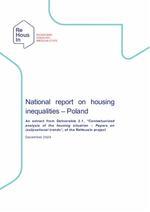National report on housing inequalities – Poland
An extract from Deliverable 2.1 “Contextualized analysis of the housing situation – Papers on (sub)national trends”
Poland's population has declined by over 2% in the last decade, and aging is a pressing concern, with seniors (65+) expected to make up 25% of the population. Over 80% of households live in privately owned homes, with mortgages financing approximately 10% of properties. Housing prices have surged, with primary market prices up 50% since 2015 and secondary market prices nearly doubling. Rental prices have risen by 60%, driven by inflation, refugee demand, and reduced housing loan accessibility. Housing costs remain a significant burden, with over 90% of households perceiving them as such since 2010. Persistent housing shortages, price inflation, and limited government intervention continue to hinder market accessibility. Overcrowding rates have dropped from over 40% in the 2000s to 30% in the 2010s, thanks to increased housing production and population decline. However, urban-rural disparities persist, with rural areas experiencing inferior housing standards, despite better conditions in noise and sunlight exposure.

Publication date: